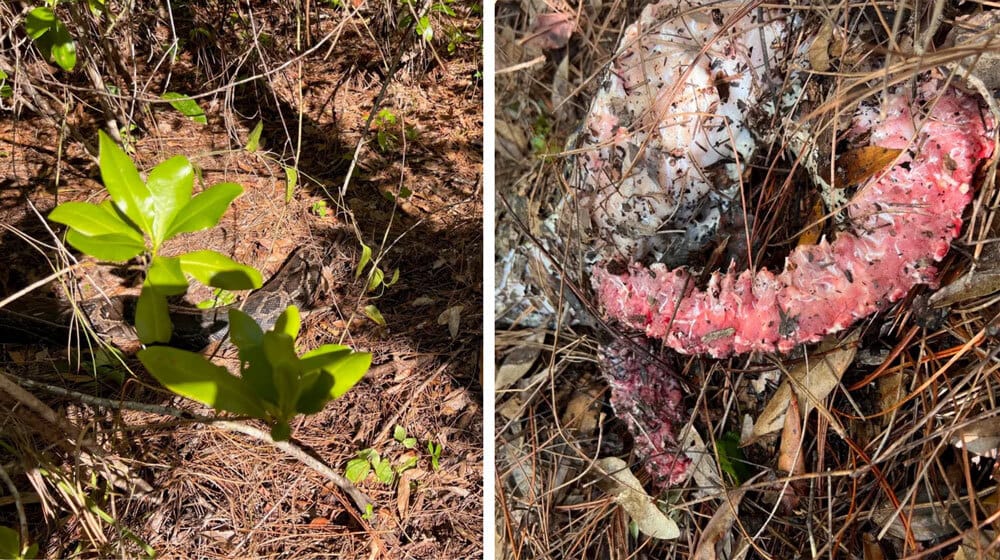
I’m currently at the “it’s Thursday already?” phase of the workweek and am unsure as to whether or not that is a good thing as of yet.
With that in mind, let’s all take a minute to grab a coffee or whiskey (no judgement) and get this Thursday morning dispatch out the door.
Here's what's worth reading about today:
We the people - Group of daring Canadians attempting to circumvent government red tape on grizzly relocation ✊
Our snakes heads are fallin’ off - Bobcats are earning their keep down in the Everglades 🐍
Plant poaching - How poachers are pushing a rare and beautiful orchid to extinction 🌱
Sudden death - 15 cows drop dead on a Colorado ranch and no one knows why 🐮
Sickly - Watch this unreal footage of a buck that is right out of his damn mind 🥴
IT’S NOBLE, BUT WILL IT WORK?
ROGUE GROUP OF CANADIANS FIGHTING TO RELOCATE A PROBLEM GRIZZLY WITHOUT GOVERNMENT CONSENT
Marked with a yellow ear tag, a large male grizzly bear has captured the attention of the local residents on a small island wedged between British Columbia’s mainland and Vancouver Island. The bear, nicknamed “Tex,” is believed to have arrived under his own power, likely swimming from the mainland’s Powell River area to Texada Island, late last month and has since caused quite a stir for the quiet and remote community.
The bear was spotted last weekend roaming around Shehtekwahn Bay and even wandering into a backyard, but the bear, who has been relocated in two previous instances, has yet to show any signs of aggression. Despite his calm demeanor, his presence has residents feeling a bit uneasy, prompting calls to secure garbage, keep pets close, and report sightings to authorities.
In addition to the calls for security, a small group has since launched a grassroots operation in an attempt to privately relocate the bear…
HEADLINES // DIGESTIBLE SNIPPETS

Left: the cached snake’s body and Right: the snake’s head and neck separated | Conservancy of Southwest Florida
🐍 Bobcats are getting in on the action, now decapitating invasive pythons in the Florida Everglades. While we all love watching the wild men of south Florida dive and tackle larger snakes than I, for one, would like to know exist, it’s also nice to know that some of our native flora and fauna is pitching in as well.
Wildlife biologist Ian Bartoszek and his team from the Conservancy of Southwest Florida discovered a 13-foot, 52-pound male Burmese python named Loki, a radio-tagged “scout snake,” dead and decapitated, buried in pine needles. Initially suspecting a Florida panther, the team collaborated with David Shindle of the U.S. Fish and Wildlife Service, who set up a trail camera. The footage revealed an adult bobcat, weighing about 25 pounds, returning to feed on the snake, with caching behavior and bobcat claws found in another python’s remains confirming the feline as the likely killer.
This rare event marks the first documented case of a bobcat feeding on, and possibly killing, a Burmese python in Florida, offering hope for the Everglades’ embattled ecosystem. Invasive since the 1990s via the exotic pet trade, pythons have devastated native wildlife, impacting nearly 85 species like rabbits and raccoons, with few natural predators. The Conservancy’s 12-year tracking program uses scout snakes to locate breeding females, and this incident joins reports of alligators, black bears, and a 2021 bobcat egg raid as signs of native species fighting back. The bobcat’s bold move, dubbed a “score for the home team,” suggests the ecosystem may be adapting, especially when cold weather weakens these invasive snakes.
🌱 A different kind of poacher is plaguing the beauty of Florida’s Everglades and threatening the survival of an extremely rare orchid. While bragging rights might look different to each and every one of us, poachers of a different kind are turning their attention from targeting big-racked whitetails or gators to a rare and at-risk orchid.
Florida’s ghost orchid (Dendrophylax lindenii), a federally endangered species, known for its delicate, white, ghost-like blooms, thrives in the swampy forests of the Everglades and parts of the Caribbean but is increasingly coveted on the black market, where collectors pay upwards of $150,000 for one single plant. The U.S. Fish and Wildlife Service (USFWS) has noted a recent surge in illegal harvesting, with poachers removing the orchids from their natural habitats, further damaging already fragile ecosystems strained by development, logging, and wetland drainage.
With only an estimated few hundred to a thousand ghost orchids left in Florida’s wild, the combined pressures of habitat loss and poaching have raised alarms about the species’ survival. Conservationists and the USFWS are calling for stronger enforcement of the Endangered Species Act, increased patrols in vulnerable areas, and greater public awareness to curb the threat. Groups like the Conservancy of Southwest Florida (these guys are busy) are also monitoring populations and cultivating orchids for potential reintroduction.
🐮 Colorado Ranch Grapples with Mystery of 15 Sudden Cattle Deaths. In a baffling incident that took place on May 8th, the Higgs family, ranchers for a decade near Coal Creek in Fremont County, Colorado, lost 15 cattle, most of which were first-time heifers and some calves, in a single day. The animals suffered seizures and collapsed, a phenomenon Kerri Higgs and her husband, a lifelong cowboy, had never seen before. The county sheriff and a local veterinarian initially suspected sulfate poisoning from water in a pasture with an old oil well, but tests on troughs and pooled rainwater ruled this out, leaving the cause undetermined. The Colorado Energy and Carbon Management Commission (ECMC) plans further tests for gasses and soil contamination, yet weeks later, the family remains without answers, shifting from devastation to frustration in their quest for clarity.
The financial hit for the ranchers is steep, with an immediate loss of $50,000 to $70,000, and a long-term impact estimated at $250,000 due to the 13 heifers’ lost potential to produce calves over 12 years each. Despite the setback, the Higgs family is determined to continue ranching, bolstered by a GoFundMe campaign to aid recovery. The case echoes a prior mystery in Crook County, Wyoming, where rancher Clint Snook lost over 40 cows across two summers, possibly to a plant toxin, though no cause was confirmed.
VIDEO // SOME THINGS JUST HAVE TO BE SEEN
🥊 This is one of the most unusual whitetail encounters I’ve ever seen. I know, I know, we’d all like to think that we could sneak up on a buck like this, but unfortunately in this case, I think there’s a lot more at play here.
Ain’t no doubt this poor old boy is sick, sick, sick…
RECOMMENDED READING // “ALMOST FRIDAY” DISTRACTIONS
Buried Treasure: What a hunter will do to recover a lost duck call: This could be the funniest true duck-hunting story ever told. It involves a high-speed truck chase, a landfill, a grown man crying his eyes out, and a very understanding wife. And there’s hardly any hunting in it. Which is pure genius.
It took place many years ago during a two-week stretch of bitterly cold central-Arkansas weather. Snow covered the rice fields, ice cloaked the trees, and when the power went out, folks knew it might be days—or weeks—before it came back on. A rice farmer named Shane and his wife, Lisa, were packing up the house to leave when Lisa’s cousin called Shane to tell him that he’d found an open creek, and the mallards were pouring in. “Come on,” he told Shane. “Right now.” Shane had no business going hunting at the time, but he left within minutes, driving his wife’s new Yukon. Read the full story.
🦌 The Border Buck: When the third week of deer season rolled around, there was still no tracking snow to be found. What little was in the high country, had pretty much melted away. The rut starts about the 15th of November in the north country, so this was the week that the bucks would be ramming around day and night. Rylan, like me, has a hard time sitting so still hunting was on the agenda. We rambled around various places and bumped into some deer, but none that we could identify as a buck.
Rylan didn’t even apply for a doe permit, so finding a good buck was on the agenda. One of the mornings, I told Rylan we were going to hunt our way into a spot that I had found while hunting with Billy the previous week. I found the spot while hurrying to get out of the woods before dark one day. It was a fairly flat area in the softwoods, with a low ridge in the middle of it. There were more rubs and scrapes in that area than I had seen in a long time. I knew the chances of seeing a buck there were fairly high. Read the full story.
✍️ Handgunning for Hogs: It was midday, and most of the wild pigs on southern California’s sprawling Tejon Ranch were bedded down in heavy brush and steep canyons. Most of the hunters in our party had taken their cue from the pigs and headed back to the cabin for a snooze. But Myles and I weren’t ready to quit yet, and our guide, Bryan, had an idea.
He stopped the truck across a shallow creek from a narrow ravine that cut down one of Tejon’s steep, grassy hillsides. About a third of the way up the ravine was a small, thick patch of brush.
“I often see pigs bed in that brushy patch,” Bryan said. “I think if we post one person on the lower side, and two of us walk into the brush, we might kick some out.”
Bryan had his work cut out for him, since Myles and I were handgun hunting. We’d already had to pass up several shots at pigs that were beyond the range of our big revolvers, and I could tell Bryan was getting a little frustrated at our limitations. I, however, was enjoying the hunt immensely. Carrying handguns was forcing us to really make use of our hunting skills as we tried to get within fifty yards or less of Tejon’s hyper-alert hogs. Had we been hunting with rifles, we’d probably both have tagged out the day before. Read the full story.
WANDERINGS // A SFW GLIMPSE OF OUR BROWSER HISTORY
I like to think that I can size most assholes up when I meet them, but I’ve definitely been proven wrong on occasion. I obviously don’t have every one of these 13 characteristics that can make someone dangerously good at reading people. I think the majority of men out there ought to be able to hang with the Army’s new fitness test - here’s what it takes. Are cell phone batteries the new match books? Here’s how to start a fire with one if you had to. Considering there were no cell phones back in the day, this collection of bizarre vintage photographs proves why we shouldn’t have had them then and probably shouldn’t have them now.
EYE CANDY // PICTURES > WORDS

You comin’?
📸 by: @peter.mather.photography
Oh, and one more thing…


